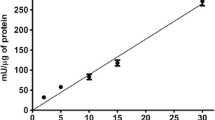Summary
Midguts dissected from imagines of Calliphora erythrocephala 10 to 20 days old were homogenized with a 0.6% solution of NaCl. After centrifugation the supernatant was assayed for carbohydrase activity by measuring liberated glucose or fructose. Results:
-
1.
Of 13 carbohydrates incubated, only sucrose, maltose, trehalose, α-methylglucoside, melibiose, amylum, and glycogen are hydrolized; cellobiose, inulobiose, lactose, and inulin are not digested by the extract (Table 1).
-
2.
With all substrates tested only one pH-optimum of hydrolytic activity is found at pH 5.4, with exception of “trehalase” activity which has a second peak at pH 5.8 (Figs. 3 and 4).
-
3.
Relative activities of the same extract against various substrates were determined (Table 2), as well as remaining activities after addition of 1% NaF to the incubation mixture (Figs. 5 and 6).
-
4.
Hydrolysis of all substrates split could be performed by α-glucosidase and α-galactosidase activity only. There is no need for β-fructosidase activity, nor could this be detected by separate experiments.
The experimental results allow two hypotheses about carbohydrase action in the midgut of Calliphora: Apart from an amylase and a trehalase there might be either a single enzyme, which combines α-glucosidase and α-galactosidase activities, or separate enzymes for each group of substrates.
Zusammenfassung
An 10–20 Tage alten Imagines der Wildform von Calliphora erythrocephala wurde die Verdauung verschiedener Kohlenhydrate untersucht:
-
1.
Bei der Inkubation mit Darmextrakt werden Saccharose, Maltose, Trehalose, α-Methylglukosid, Melibiose, Stärke und Glykogen gespalten; Inulobiose, Cellobiose, Laktose und Inulin werden nicht angegriffen.
-
2.
Die pH-Abhängigkeit und die relative Größe der Spaltung wurden für die einzelnen Substrate quantitativ bestimmt.
-
3.
Durch diese Tests und durch Hemmversuche mit Natriumfluorid konnte wahrscheinlich gemacht werden, daß bei der Spaltung der angegebenen Substrate nur α-glukosidische und α-galaktosidische, nicht aber β-fruktosidische Bindungen gelöst werden.
Die Ergebnisse lassen zwei Hypothesen über die Art der Carbohydrasen im Darmextrakt zu. Es können vorhanden sein: a) ein Komplex mit α-glukosidischer und α-galaktosidischer Wirkung und daneben eine spezifische Trehalase, die vielleicht zum Teil aus der Darmwand stammt, sowie eine Amylase; b) neben einer Amylase und der spezifischen Trehalase eine generelle α-Glukosidase und eine α-Galaktosidase. Eine β-Fructosidase ist mit großer Wahrscheinlichkeit nicht vorhanden.
Similar content being viewed by others
Literatur
Bhatnagar, P. L.: The fate of certain carbohydrates in the gut of Oxycarenus hyalinipennis Costa. Naturwissenschaften 51, 17 (1964).
Evans, W. A. L.: Digestive enzymes of the blowfly Calliphora erythrocephala I: The carbohydrases. Exp. Parasit. 5, 191–206 (1956).
Fraenkel, G.: Utilization and digestion of carbohydrates by the adult blowfly. J. exp. Biol. 17, 19–29 (1940).
Graham-Smith, G. S.: The alimentary canal of Calliphora erythrocephala with special reference to its musculature and the proventriculus, rectal valve and rectal papillae. Parasitology 26, 176–248 (1934).
Hansen, K.: Zur cytologischen Lokalisation der Trehalase in der indirekten Flugmuskulatur der Insekten. Biochem. Z. 344, 15–25 (1966).
Haslinger, F.: Über den Geschmackssinn von Calliphora erythrocephala Meig. und über die Verwertung von Zuckern und Zuckeralkoholen durch diese Fliege. Z. vergl. Physiol. 22, 614–640 (1935).
Langer, H.: Zur Bestimmung einer Fraktion des „freien Zuckers“ in Insektengewebe. Z. Naturforsch. 14b, 480–481 (1959).
—: Über den chemischen Aufbau des Facettenauges von Calliphora erythrocephala Meig. und seine Veränderungen mit dem Imaginalalter. Z. vergl. Physiol. 42, 595–626 (1960).
Messer, M., and A. Dahlqvist: A one-step ultramicro method for the assay of intestinal disaccharidases. Analyt. Biochem. 14, 376–392 (1966).
Pazur, J. H., and A. L. Gordon: The preparation and properties of inulobiose. J. Amer. chem. Soc. 75, 3458–3460 (1963).
Saxena, K. N., and P. L. Bhatnagar: Nature and characteristics on invertase in relation to utilization of sucrose in the gut of Oxycarenus hyalinipennis (Costa) (Heteroptera: Lygaeidae). J. Insect. Physiol. 7, 109–126 (1961).
Waterhouse, D. F.: Digestion in insects. Ann. Rev. Entomol. 2, 1–18 (1957).
Author information
Authors and Affiliations
Additional information
Für die Anregung zu dieser Arbeit und sein ständiges Interesse am Fortschritt derselben möchte ich Herrn Prof. Dr. H. Langer herzlich danken.
Die Untersuchungen wurden mit Geräten durchgeführt, die Herrn Prof. Dr. H. Langer von der Deutschen Forschungsgemeinschaft zur Verfügung gestellt wurden.
Rights and permissions
About this article
Cite this article
Wenzl, H. Spaltung von Kohlenhydraten durch die Enzyme des Mitteldarms von Calliphora erythrocephala . Z. Vergl. Physiol. 62, 167–182 (1969). https://doi.org/10.1007/BF00302281
Received:
Issue Date:
DOI: https://doi.org/10.1007/BF00302281




